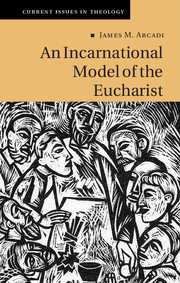20 results
David L. Stubbs, Table and Temple: The Christian Eucharist and its Jewish Roots (Grand Rapids, MI: William B. Eerdmans, 2020), pp. xvii + 403. $40.00.
-
- Journal:
- Scottish Journal of Theology / Volume 75 / Issue 1 / February 2022
- Published online by Cambridge University Press:
- 25 March 2022, pp. 81-83
- Print publication:
- February 2022
-
- Article
- Export citation
Homo adorans: exitus et reditus in theological anthropology
-
- Journal:
- Scottish Journal of Theology / Volume 73 / Issue 1 / February 2020
- Published online by Cambridge University Press:
- 20 February 2020, pp. 1-12
- Print publication:
- February 2020
-
- Article
-
- You have access
- HTML
- Export citation
Discerning the Body of Christ: A Retrieval of Thomas Cranmer’s Eucharistic Theology by Way of the Spiritual Senses
-
- Journal:
- Journal of Anglican Studies / Volume 17 / Issue 2 / November 2019
- Published online by Cambridge University Press:
- 22 July 2019, pp. 183-197
-
- Article
- Export citation
Copyright page
-
- Book:
- An Incarnational Model of the Eucharist
- Published online:
- 11 May 2018
- Print publication:
- 31 May 2018, pp iv-iv
-
- Chapter
- Export citation
2 - Known in the Breaking of Bread: A Biblical–Theological Foundation for the Eucharist
-
- Book:
- An Incarnational Model of the Eucharist
- Published online:
- 11 May 2018
- Print publication:
- 31 May 2018, pp 26-61
-
- Chapter
- Export citation
1 - Discerning the Body of Christ
-
- Book:
- An Incarnational Model of the Eucharist
- Published online:
- 11 May 2018
- Print publication:
- 31 May 2018, pp 1-25
-
- Chapter
- Export citation
3 - ‘Holy to the Lord’: Speech-Acts, Consecration, and the Divine Presence
-
- Book:
- An Incarnational Model of the Eucharist
- Published online:
- 11 May 2018
- Print publication:
- 31 May 2018, pp 62-110
-
- Chapter
- Export citation
Dedication
-
- Book:
- An Incarnational Model of the Eucharist
- Published online:
- 11 May 2018
- Print publication:
- 31 May 2018, pp v-vi
-
- Chapter
- Export citation
4 - What’s in a (Re)Name? That Which We Call Bread, by Another Name Would Be Christ’s Body
-
- Book:
- An Incarnational Model of the Eucharist
- Published online:
- 11 May 2018
- Print publication:
- 31 May 2018, pp 111-141
-
- Chapter
- Export citation
7 - Sacramental Impanation: An Incarnational Model of the Eucharist
-
- Book:
- An Incarnational Model of the Eucharist
- Published online:
- 11 May 2018
- Print publication:
- 31 May 2018, pp 240-281
-
- Chapter
- Export citation
Tables
-
- Book:
- An Incarnational Model of the Eucharist
- Published online:
- 11 May 2018
- Print publication:
- 31 May 2018, pp x-x
-
- Chapter
- Export citation
6 - Varieties of Impanation
-
- Book:
- An Incarnational Model of the Eucharist
- Published online:
- 11 May 2018
- Print publication:
- 31 May 2018, pp 193-239
-
- Chapter
- Export citation
Bibliography
-
- Book:
- An Incarnational Model of the Eucharist
- Published online:
- 11 May 2018
- Print publication:
- 31 May 2018, pp 291-302
-
- Chapter
- Export citation
Preface
-
- Book:
- An Incarnational Model of the Eucharist
- Published online:
- 11 May 2018
- Print publication:
- 31 May 2018, pp xi-xiv
-
- Chapter
- Export citation
Index
-
- Book:
- An Incarnational Model of the Eucharist
- Published online:
- 11 May 2018
- Print publication:
- 31 May 2018, pp 303-306
-
- Chapter
- Export citation
5 - Christology for the Eucharist
-
- Book:
- An Incarnational Model of the Eucharist
- Published online:
- 11 May 2018
- Print publication:
- 31 May 2018, pp 142-192
-
- Chapter
- Export citation
Contents
-
- Book:
- An Incarnational Model of the Eucharist
- Published online:
- 11 May 2018
- Print publication:
- 31 May 2018, pp vii-ix
-
- Chapter
- Export citation
Epilogue
-
- Book:
- An Incarnational Model of the Eucharist
- Published online:
- 11 May 2018
- Print publication:
- 31 May 2018, pp 282-290
-
- Chapter
- Export citation

An Incarnational Model of the Eucharist
-
- Published online:
- 11 May 2018
- Print publication:
- 31 May 2018
Impanation, incarnation, and enabling externalism
-
- Journal:
- Religious Studies / Volume 51 / Issue 1 / March 2015
- Published online by Cambridge University Press:
- 10 July 2014, pp. 75-90
- Print publication:
- March 2015
-
- Article
- Export citation



